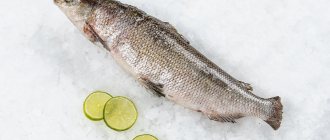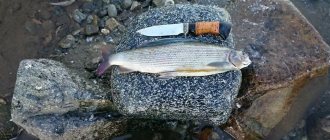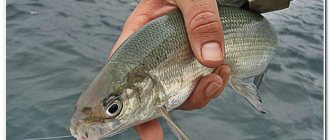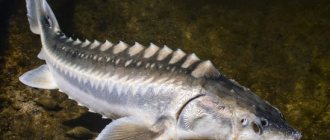There are many salmon fish, one of the families is whitefish, a numerous, little-studied fish genus with variable characteristics. Representatives of this family have a laterally compressed body and a small mouth for their size, which causes a lot of inconvenience for fans of fishing with a rod. The lip of a whitefish often cannot withstand the load when it is pulled out of the water, and when the lip breaks off, the fish leaves.
Due to the similarity of the silhouette of the whitefish’s head with the head of a herring, whitefish are also called herring , and only the adipose fin clearly indicates their salmon origin. The extremely high degree of variability of characters still does not allow us to establish the exact number of their species: in each lake it is possible to establish its own special species, for example, 43 forms were identified in the lakes of the Kola Peninsula alone. Currently, work is underway to combine similar forms into one species, which should lead to the systematization of fish species of the whitefish family.
General description of the family
On the territory of Russia there are over a hundred varieties of fish of this family, which have excellent taste and other beneficial properties. Its habitat is almost all bodies of water from the Kola Peninsula in the west to the Kamchatka and Chukotka Peninsulas in the east. Although this fish belongs to the salmon family , its meat is white, sometimes pinkish in color. Often, even experienced fishermen do not even suspect that the Baikal omul is the same whitefish. Here is a small list of the names of fish of the whitefish family:
- largemouth and European vendace (ripus), Atlantic and Baltic whitefish;
- whitefish Volkhovsky, Bauntovsky and Siberian (Pyzhyan), Baikal omul;
- Muksun, Tugun, Valaamka and Chir (Shokur).
This diverse fish does not have a single appearance, but all members of the family have uniform silvery scales and darkened fins. The adipose fin, a distinctive feature of all salmonids, is also a common feature of fish of the whitefish genus. A distinctive feature of females is their scales; unlike the scales of males, they are larger and have a yellowish tint.
Whitefish: description, types and spawning. Where is whitefish found and what does it eat?
Fishes of this group are the most difficult of all to accurately systematize, since they form vast types of races, tribes and forms. Whitefish came to us, no less, from the Ice Age, becoming, in fact, a semblance of relict organisms.
Description of whitefish
Coregonus or whitefish is a genus of the family Salmonidae (salmon). Some scientists place it in a separate whitefish family, along with nelma and whitefish.
The whitefish is distinguished by its compressed body, covered with medium-sized scales, and a medium-sized mouth that does not have teeth on the vomer and maxillary bones.
The teeth in other parts of the oral cavity are either extremely poorly developed or disappear over time.
Another distinctive feature of the whitefish is that its upper jaw bone does not extend beyond the eye. Common characteristics of whitefish also include the fact that the position of the mouth often changes - from almost terminal to typically inferior, depending on the species and shape. You can also trace the presence of a snout platform, the height of which is less than its width.
In size, whitefish are relatively small, with a standard length reaching up to half a meter (usually 40...50 cm) with an average weight of 700...800 g. However, the most powerful forms of whitefish are also found - weighing approximately 1000 g with a body length of 50...60 cm . There are also whitefish weighing from 3000 g to 5000 g.
Almost all representatives of whitefish have a light color - silver-white or silver-gray sides against a darkish back , giving off olive-brown, green or lilac tones, and a milky-light or slightly grayish belly.
The fins, on the contrary, are darker and can even be black. The intensity of this color varies slightly in each variety and form. Whitefish do not have spots on their fins or body.
This is accurately reflected in its name in English - “white fish”, which translates as “white fish”.
Types of whitefish
Despite the enormous diversity of forms, tribes and races, whitefish are usually divided into three basic species based on habitat :
- lake whitefish;
- passing whitefish;
- river whitefish.
The most common of them is river whitefish. It enters rivers from large lakes and seas to spawn. As a rule, it is somewhat longer and darker than the described varieties, with a small head and a blunt, rounded nose.
Above the lateral line it has not 10, like all other whitefish, but 11 scales.
The number of its gill rakers coincides with their number in the sandpiper, however, in this whitefish the body is even more flattened laterally and the back rises straight from the back of the head to the dorsal fin in a fairly flat arc. The ventral and pectoral fins are pointed.
The color of the back is grayish-green, with steely overtones. The sides are silvery, blue in color and have longitudinal light stripes. The iris of the eyes is silvery, grayish on top. The average weight of river whitefish is 2...4 pounds (rarely - 7).
In addition, whitefish are divided into species and according to the depth of their habitat :
- pelagic;
- coastal;
- deep-sea.
Where are whitefish found?
Whitefish is a commercial fish species, therefore it was acclimatized in the water sources of most zones of Russia and the post-Soviet space.
Very successful whitefish production is developed in the Gulf of Finland, Peipus, Onega, Ladoga and other local lakes.
It widely covers the Kola Peninsula, choosing to live there mainly the largest lakes - Seydozero, Pankunyavr, Umbozero and Lovozero.
In addition, whitefish inhabit the vast majority of water bodies located in the Arctic Ocean basin - from the White Sea and the Barents Sea to Chukotka.
It is also found in rivers such as Penzhina and Anadyr, and is no less common in the Baltic Sea basin, where it is especially widely represented in Karelian reservoirs and the Curonian Lagoon.
And in the Transbaikalia zone there is an extremely amazing whitefish, the spawning of which occurs in early spring (it is classified as a special subspecies).
- Whitefish also live in the waters of the North American continent , populating the waters of Alaska and Canada. For the most part it prefers rivers, although it is also found in seas and lakes (where it survives the winter cold). All these forms have individual differences among themselves - in fins, color, nose, etc.
- What they have in common is that whitefish choose cold and temperate countries in the northern hemisphere as their main habitat.
- For the most part, they are deep-sea inhabitants and extremely adhere to the bottom, which is why, when lifted up by nets, they sometimes become greatly inflated (due to the expansion of the swim bladder), like many deep-sea fish.
What does whitefish eat?
Basically, whitefish are predatory fish with extremely cautious habits , but in large bodies of water (such as lakes), whitefish have a different feeding pattern, given their division into pelagic, coastal and deep-sea inhabitants: they range from atypical benthophages to habitual planktivores .
Whitefish often become predatory, devouring the eggs of both their own species and other fish.
Their standard diet includes most insects (aquatic or semi-aquatic), mollusks, crustaceans, larvae, etc. However, the whitefish does not pass by the fry, juveniles, including its own species, as well as smelt and other fish.
Whitefish spawning
The beginning of spawning in whitefish occurs at 4-5 years of age in males and 5-6 years in females . In terms of timing, it usually falls in the autumn, but due to the length of the autumn period it often stretches, including the winter months. However, this is due not only to the duration of autumn and the remoteness of cold weather, but also to the zonal extent of the reservoirs in which it lives.
Thus, whitefish spawning begins in September (traditionally in the middle) and ends in November, and in some reservoirs even at the end of December–early January . It chooses shallow bodies of water as spawning sites, swimming into rivers from seas and lakes.
During feeding, adult individuals stick to shallow water - open areas of lakes and areas of coastal dumps, approximately 1.5...8 meters from the bottom level. But they can also swim to great depths - 8...20 meters. Whitefish spawning usually occurs at water temperatures from +5 to +1.5 degrees.
However, there are also cases of its omission.
The fertility of whitefish traditionally reaches 20 thousand/30 thousand eggs, and in one form of whitefish it is even about 50 thousand. It is slightly lighter in color than trout. They spawn on rocky areas near the bottom surface or on coarse sand.
Source: https://www.manorama.ru/article/Ryba_sig.html
Gallery: whitefish species (25 photos)
Habits and preferences
A quality common to the entire family is life in a flock, which is formed according to the age of the individuals. The preferences of whitefish are unturbid, cold water enriched with oxygen, which is usually found in rapids of rivers and in the depths of lakes. At the same time, a school of whitefish can drive representatives of other fish species out of the pit. As a rule, the larger the fish, the further it moves from the shore.
The ability to spawn in fish of the family appears at the age of about three years, and in some breeds - a year or two later. Spawning of sea and freshwater whitefish takes place in the same conditions - all of them, including lake ones, rise to the upper reaches of rivers and their tributaries. Whitefish lay eggs in the fall, when the water cools to below five degrees. The spawning areas are deep holes and quiet rivers and reaches. Here the eggs are aged until spring, when the fry emerge from the eggs as the water warms.
The diet of the whitefish family, like all predators, is of animal origin: vertebrate and invertebrate insects (worms, larvae and caterpillars, caddis flies and bark beetles), small crustaceans and mollusks, caviar. Depending on the age and, accordingly, the size of the predator itself, it also attacks fish that are smaller than it. But among whitefish there are also lovers of vegetarian food collected from the bottom, as well as omnivores - semi-predators.
Population and species status
Photo: Whitefish river fish
The genus includes a large number of species, and their status can be very different: some are not threatened and there are no restrictions on their catch, others are on the verge of extinction. In Russian reservoirs, where whitefish are most abundant, a general trend has emerged: its numbers are falling almost everywhere. Some rivers and lakes, where there used to be a lot of this fish, now have populations that are completely incomparable to previous ones. So the whitefish were affected by active fishing, and even more so by environmental pollution, because the purity of water is very important for them.
But due to the wide variety of species, the situation must be analyzed separately for each of them. For example, European vendace is widespread, and so far its population in European rivers is not threatened. The same is true for omul, which live mainly in Siberian rivers and North America. They continue to actively catch the pyzhyan in the northern rivers of Russia - so far there have been no problems with its numbers; to the east - in Siberia, Chukotka, Kamchatka, as well as in Canada, whitefish continue to be actively caught, and so far nothing threatens it.
But Atlantic whitefish are a vulnerable species, since their population has greatly decreased due to active fishing, so restrictions have been introduced. Also considered vulnerable is the common whitefish, which is accepted as a typical representative of the genus. There are also even less common whitefish; some species are even included in the Red Book.
Interesting fact: Whitefish is a perishable, oily fish, and therefore it is very important to ensure that it is fresh: whitefish that is stale or stored in poor conditions can be poisoned.
Types of whitefish
As a rule, whitefish are divided into separate groups based on mouth position. The mouth can be directed upward - the upper mouth, forward - the terminal mouth, and downwards - the lower mouth.
Topmouth are small fish that feed on what they find near the surface of the water. These are insects and invertebrates - worms and caterpillars. The fish with the upper mouth are represented mainly by the European vendace (ripus) and the larger Siberian one. The latter can be up to half a meter in length, lives in places where rivers flow into the salty waters of the sea, and is almost never found in lakes. The rhipus is half the size and is an inhabitant of lakes. Both species of vendace are commercially available.
Whitefish with a mouth in front (final) are also considered commercial fish. Omul is a large fish, over half a meter long, which, like vendace, lives in the bays of the seas and the estuaries of rivers flowing into the sea, where it rises to spawn. The diet of omul includes crustaceans and small fish. Baikal omul is a lake variety of whitefish. Another lake-river species is the peled fish (raw fish), it does not enter sea water, but is as large as vendace and omul, its length is about half a meter. It was also brought to the reservoirs of the Southern Urals, but here its size is not so impressive. There is also a small relative of whitefish with a terminal mouth - tugun, which lives in the rivers of Siberia. Its length does not exceed twenty centimeters.
Origin of the species and description

Photo: Sig
Whitefish belong to the class of ray-finned fish that arose on the planet at the end of the Silurian period. At first they developed at a slow pace, and only after about 150-170 million years, by the Triassic period, a clade of teleosts appeared - this is what whitefish belong to. But the appearance of both this species itself and the order of salmonids, of which they belong, was still far away. Only at the beginning of the Cretaceous period did another order emerge - the herrings. They acted as ancestors for salmonids, and they appeared in the middle of the Cretaceous.
But regarding the latter, scientists have different versions: fossil finds of salmon dating back to that time have not yet been discovered, and therefore their occurrence at that time still remains a theory. The earliest finds date back to the Eocene, they are approximately 55 million years old - it was a small fish that lived in fresh water.
Video: Sig
At first, there were clearly few salmonids, since there are no further fossils for a very long period, and only in layers with an antiquity of 20-25 million years do they appear, and in quite a large number at once. Species diversity increases as we approach modern times—and the first whitefish appear in these layers.
The genus name, Coregonus, comes from the ancient Greek words for “angle” and “pupil” and is due to the fact that the pupil of some whitefish species appears angular from the front. The scientific description was made by Carl Linnaeus in 1758. In total, the genus includes 68 species - however, according to different classifications there may be a different number of them.











